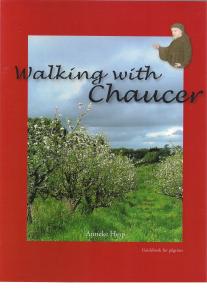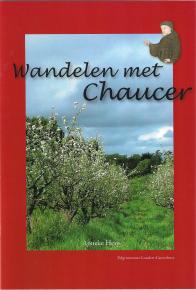Canterbury is a landmark in the ancient routes to Rome and Santiago de Compostella. In his Canterbury Tales Geoffrey Chaucer shows us how a group of medieval pilgrims find travel from London to Canterbury. Walking with Chaucer takes you from their first watering hole on a four day walk past apple orchards, pubs and hop fields to the cathedral.
Download: Tales, Maps, Route Description, Public Transport, Accommodation and Tips.
Walking with Chaucer Wandelen met Chaucer
Download: De verhalen, kaarten, overnachtingen, routebeschrijving, openbaar vervoer en tips.
Canterbury is altijd een knooppunt geweest voor Britse pelgrims naar Rome en Santiago
de Compostella. De moord op Thomas Becket maakte de kathedraal beroemd als bedevaartsoort en Geoffrey Chaucer beschreef de pelgrims en hun verhalen in The Canterbury Tales. Appelboomgaarden, pubs en hopvelden zijn het decor voor wie verder wil lopen dan snelwegen en dubbeldekkers.
……………………………………………………………………………………………………………………………….
Would you rather have a paper book? Contact annekehesp@gmail.com
……………………………………………………………………………………………………………………………….
An April Walk
‘Whan that Aprill, with his shoures soote, The droghte of March hath perced to the roote
And bathed every veyne in swich licour, Of which vertu engendred is the flour……………………’
‘Than longen folk to goon on pilgrimages. And specially from every shires ende Of Engelond, to Caunterbury they wende.’
Maundy Thursday – London Bridge is noisy. Double deckers, coaches, cars and some courageous bikers stream down from the bridge into Borough High Street: trains rumble overhead. Droves of tourists and commuters try to reach the other side of the street. Just a few steps down lies Southwark Cathedral. A herb garden, some chairs and tables for the trendy restaurants in the shade of the viaduct overhead and silence. Only the footsteps of a few people looking for the famous footpath along the Thames. And three modern day Dutch ladies who would like to trace the steps of the pilgrims that tell their stories in Chaucer’s Canterbury Tales.
This is the place where, in 1170, archbishop Thomas Beckett held his last sermon before he was murdered 56 miles to the east in Canterbury. Before long thousands of pilgrims found their way to his grave in Canterbury where the dead Beckett performed miracles by healing the sick and giving sight to the blind. Geoffrey Chaucer used the popular pilgrimage to make a framework for his Canterbury Tales, much in the same way in which Boccacio told his stories in the Decamerone.
De doors of the cathedral are open. Inside evensong is just finishing. After that we see that here three saints of English literature are honored: Shakespeare and Gower have statues, Chaucer has a stained glass window.
To the side there is a cafetaria and a souvenir shop. China dolls are sold of our predecessors on their way to Canterbury; the wife of Bath with the Madonna -slit between her front teeth, the drunken miller and the knight who has seen all the slaughter fields of Europe and beyond.
Harry Bailey, proprietor of the Tabard Inn further down Borough High Street, was host to the pilgrims. He enjoyed their company and felt like joining them. He suggested they should each tell some stories on their way to Canterbury and that the best story teller would be awarded a free meal at the Tabard Inn on the way back. The other members of the company would pay towards the costs. The whole proposal was a bit unrealistic. A crowd of 30 horseriders can’t have exchanged loads of stories on the way. Or did people have sharper ears in the Middle Ages? But then a joke every now and then could have been shared.
The Tabard Inn was still in function in the nineteenth century but now only the street name Talbot Yard is a reminder of it. Close by the George Inn offers a courtyard in a setting that goes back 500 years. It still caters to the lunch and dinner crowds. Outside in summer and inside when the weather is colder. Just past Talbot Street is St Christopher’s Village, a modern paradise for back packers.
Chaucer must have known the route by heart. As a diplomat he frequently travelled to the Continent: Flanders, France, Italy. He crossed from Dover and the old roman road to that port ran in a straight line through Canterbury. It more or less followed the old Celtic road that was called Watling Street. The street name is crops up time and again in the towns and villages along the road. Watling Street was less straight and in the Middle Ages people also used parallel alternatives depending on the condition the road was in, the weather, fear of robbers or for any other reason. Nowadays it is wise for the pilgrims to find these alternative paths because most of the Roman Road is in use as foundation for stretches of the A2.
Watling Street made use of a ford in the Thames near Westminster so the pilgrims started off down Borough High Street and after half a mile turned eastward into what is now the A2. Just before is a residential area with street names such as Tabard Street, Pilgrimage Road, Pardoner’s and Manciple Street. The A2 runs past what Chaucer called St. Thomas-a-Wateringhe. It is now Burgess Park and for the pilgrims probably the first sanitary stop. From now on the top of a double decker is the best place to admire the roman road. Just past Greenwhich (where Chaucer lived while he was working on the Canterbury Tales) a change to the 89 until Dartford where Watling Street is a pedestrian area with market stalls, a fountain and a shopping mall. From here double decker 96 takes us to Bluewater, an open chalk pit that has been transformed into a luxurious you-can-have-it-all-as-long-as-you-pay-for-it.
The way out of the chalk mine is hard to find for a pedestrian. Only the gardeners know the emergency road that leads up to a small gate in the fence and the cemetery of Stone. But fortunately the bus makes a stop at Darenth Hospital and there we see the power lines that lead into Darenth Wood. We could cross the open field but there is a crop. An alternative is to follow the old roman road out of London. Here it is the A296 in the direction of Gravesend for a bit. We take the small road into the wood on our right and we cross the power lines anyway and later the droning A2. Out in the open we follow the edge of the wood towards a farm and then on to the village of Bean and a public footpath to Betsham and Southfleet.
Good Friday – Cobham is not far away. Opposite the old church is The Leather Bottle. Charles Dickens and his Pickwick Club were regular visitors to the pub. This is definitely not only Chaucer country but Dickens country too. The greenway leads straight as a dye through Cobham Park to Strood, a suburb of Rochester. Jack Ravensdale, the author of In the Steps of Chaucer’s Pilgrims, used aerial photography in his book to show the more abundant tree growth that marks the path. In the middle of the woods there is a mausoleum that was never used. The church gave no permission to the lord of Cobham Hall for a tomb outside of the church cemetery.
Rochester means another bus that leaves from Albatross Avenue and drops us off after the bridge over the Medway. The cathedral and castle were here long before Chaucer’s time. There are enough possibilities for a lunch break: in the sun on the graas in front of the castle or in a café in High Street. After that we take the train past the built up area of Chatham en Gillingham and walk towards the east out of Rainham to Newington. A playground, some houses, a golf club and then glorious apple orchards and farm land all the way to Bobbing, high above the town of Sittingbourne. The doors to the Norman church are open. That is strange because vandalism seems a big problem in this area. At first the inside looks like a day nursery with tables with crayons, beads and materials for arts and crafts. There are couches and we spot a teamaker and a note that invites us to fresh water and teabags. And if we feel like it, we can express our thoughts by very means that has been put ready for us. The ladies of the village offer recipebooks and the history of the church is explained. The churchwarden comes in to prepare a viewing of Passion of the Christ that evening. We are very welcome to stay and watch.
Chaucer mentions a place called Bob-up-and-doun and he knew the man who was in charge at the time. But many scholars think that not Bobbing but Harbledown, nearer to Canterbury was Bob-up-and-doun. I can’t believe that. This welcoming church must have had a place in Chaucer’s work.
Saturday – We leave Sittingbourne by way of Pelegrino Road and then follow a footpath to Rodmersham and straight on to Loyterton. The path climbs higher: first through fields full of sheep, later on through apple and hop fields. To the North we see the water of the Swale and the Isle of Sheppey. Near the waterworks we dive under the M2 and follow the road to the east until we reach a bridge over the motorway. On the other side we find a public footpath that brings us past fields full of rape to a small church and the Maison Dieu of Ospringe. According to the tradition this is where the pilgrims spent their last night before moving on to Canterbury. We have a drink in the beer garden on the other side of the A2 and walk on past Faversham Station. In a small park we find the Preston Bridge, apparently with 185 meters the longest pedestrian railway crossing in the United Kingdom. More orchards and we have to cross the dangerous A 299. Behind Farmer’s World we follow a track down to Boughton Street with it medieval houses.
Easter – Today we will reach Canterbury. The roman road leads up to Dunkirk with its old church. We hear faint music and singing as we walk past. At the end of the village there is another dangerous crossing towards the petrol station and into the woods. We can’t get out where the map promises us we can and we get lost. We stop and consider. Where is the sun? Where is this open field we are supposed to see? Why can’t we see this barn on the map? We draw the conclusion that the original path has been blocked and then find our way to Chartham Hatch where we catch up with the North Downs Way which we follow as far as Harbledown. We leave it to have a look at Saint Nicholas Hospital. It was there that an old man showed a shoe to our compatriot Erasmus. This shoe, he said had belonged to Thomas Becket. Erasmus was invited to kiss the shoe in exchange for some money. He was sure Erasmus would be blessed ever since. The invitation was declined the invitation but Erasmus gave the man some money anyway because he had told such a good story. Past Harbledown we have our fist full sight of Canterbury Cathedral. We cross the road and walk into Canterbury towards the Westgate. The streets are full on this Easter Day. A quarter of an hour later we are just in time to be in the cathedral for evensong.
The remains of Thomas Beckett are no longer in the crypt however. Henry the Eighth had them removed because he wanted to put a stop to the pilgrimages.


